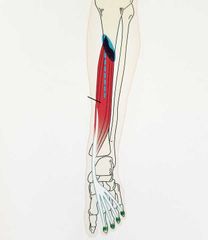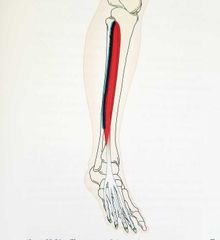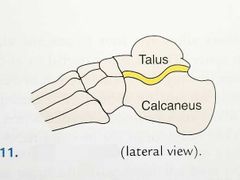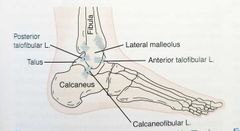![]()
![]()
![]()
Use LEFT and RIGHT arrow keys to navigate between flashcards;
Use UP and DOWN arrow keys to flip the card;
H to show hint;
A reads text to speech;
105 Cards in this Set
- Front
- Back
- 3rd side (hint)

|
Rectus femoris |
|
|

|
1. Vastus lateralis 2. Vastus intermedius 3. Vastus medialis |
|
|

|
1. Semitendinosus 2. Biceps femoris, long head 3. Semimembranosus 4. Biceps femoris, short head |
|
|

|
Popliteus |
|
|

|
Gastrocnemius |
|
|
|
What is the ROM and end feels for knee flexion and extension? |
Flexion 0-135 soft or firm Extension 0 firm |
|
|
|
The knee joint is the largest joint in the body, and it is classified as a ____ ____ joint. |
Synovial, hinge However, it is not a true hinge because it has a rotational component. |
|
|
|
The last motion that occurs during knee extension is called what? |
Screw home mechanism |
|
|
|
What type of relationship do the femur and tibia have in a closed chain action? |
Convex on concave |
|
|
|
What is open-packed position for the knee? Close-packed? What is the capsular pattern? |
OP: 25* flexion CP: full ext. with ER of tibia CP: flexion > extension |
|
|
|
Articulation between thigh bone and small bone on top of knee |
Patellofemoral |
|
|
|
What are the main functions of the patella? |
Increase mechanical advantage of quadriceps Protect knee joint |
|
|
|
Angle between the quadriceps and the patellar tendon |
Q angle: normal range is 13-19* Many knee and patellar problems are associated with abnormal Q angles. |

|
|
|
What is open-packed position for the patellofemoral joint? |
Knee fully extended |
|
|
|
Large projection at the proximal end of the tibia on the anterior surface |
Tibial tuberosity |
|
|
|
The ACL and PCL are named for their attachment on the ____. |
Tibia |
|
|

|
1. Anterior cruciate ligament 2. Lateral collateral ligament 3. Medial collateral ligament 4. Medial meniscus 5. Posterior cruciate ligament |
|
|
|
The ____ ligaments provide stability in the sagittal plane while the ____ ligaments provide stability in the frontal plane. |
Cruciate, collateral |
|
|
|
The ACL tightens during ____, and the PCL tightens during ____. |
Extension, flexion The ACL is injured much more frequently than the PCL. |
|
|
|
Which collateral ligament is attached to a meniscus? |
Medial collateral ligament This contributes to frequent tearing of the medial meniscus. |
|
|
|
A blow to the lateral side of the knee is a ____ force while one to the medial side is a ____ force. |
Valgus, varus |
|
|
|
What are two functions of the menisci? |
Absorb shock Deepen tibial surface |
|
|
|
Which nerves and blood vessels run through the popliteal space? |
Tibial and common fibula (nerve) Popliteal artery and vein |
|
|
|
From anterior to posterior, the sartorius, gracilis, and semitendinosus make up the ____ ____. |
Pes anserine |
|
|
|
When a person is knock-kneed (____ ____), the weight of the body is centered to the ____ side of the knee joint and the ____ is stretched. |
Genu valgum, lateral, MCL |
|
|
|
When a person is bow-legged (____ ____), the weight of the body is centered to the ____ side of the knee joint and the ____ is stretched. |
Genu varus, medial, LCL |
|
|
|
Which muscles wrap around the sides of the femur? |
Vastus lateralis and medialis |
|
|
|
Which part of the hamstring group functions only at the knee? |
Short head of biceps femoris |
|
|
|
Which muscle creates the rotational pull needed to unlock the knee as it begins flexion? |
Popliteus |
|
|
|
Which muscles come together to form the Achilles tendon? |
Gastrocnemius and soleus |
|
|
|
Which muscle makes it possible for a person to extend the knee without using the quads? |
Gastrocnemius |
|
|
|
Which muscles do not have a prime mover function at the knee but do help to stabilize the joint? |
Gracilis Sartorius Tensor fascia lata |
|
|
|
The ____ nerve innervates the quads, and the ____ nerve innervates the hamstrings. |
Femoral, sciatic |
|
|
|
Coxa varus is seen in conjunction with ____ ____, and coxa valgus is seen with ____ ____. |
Genu valgus, genu varus |
|
|
|
Jumper's knee; results from overuse stress or sudden impact overload |
Patellar tendonitis |
|
|
|
Common overuse injury among growing adolescents; inflammation of the growth plate on the tibial tuberosity |
Osgood-Schlatter disease |
|
|
|
Softening and degeneration of cartilage on back of patella |
Chondromalacia patella |
|
|
|
Housemaid's knee; occurs when there is constant pressure between skin and patella |
Prepatellar bursitis |
|
|
|
The terrible triad, caused by a single blow to the knee, involves tears to which structures? |
ACL, MCL, medial meniscus |
|
|
|
Problem of the LE involving increased anteversion of the femoral head; associated with genu valgus, increased tibial torsion, and flat feet |
Miserable malalignment syndrome |
|
|

|
1. Plantaris 2. Soleus |
|
|

|
Tibialis posterior |
|
|

|
Flexor hallucis longus |
|
|

|
Flexor digitorum longus |
|
|

|
Tibialis anterior |
|
|

|
Extensor hallucis longus |
|
|

|
Extensor digitorum longus |
|
|

|
Fibularis longus |
|
|

|
1. Fibularis brevis 2. Fibularis tertius |
|
|

|
1. Calcaneus 2. Talus |
|
|

|
1. Navicular 2. Cuboid 3. Third cuneiform 4. Second cuneiform 5. First cuneiform |
|
|

|
1. Metatarsal 2. Proximal phalanx 3. Middle phalanx 4. Distal phalanx |
|
|
|
Medial superior part of the calcaneus that projects out to support the talus |
Sustentaculum tali |
|
|
|
Which metatarsals bear the most weight? |
First and fifth |
|
|
|
In the gait cycle, the ____ is the first part of the foot that makes contact with the ground. |
Hindfoot |
|
|
|
What are three main functions of the ankle joint and foot? |
Act as shock absorber Adapt to level of ground Provide stable BOS |
|
|
|
Which motions do the ankle and foot allow? |
Plantar flexion/dorsiflexion - saggital plane Inversion/eversion - frontal plane Abduction/adduction - transverse plane |
|
|
|
Inversion of the foot is accompanied by ____, and eversion by ____. |
Adduction, abduction |
|
|
|
Supination of the foot is a combination of what movements? |
Plantar flexion, inversion, adduction |
|
|
|
Pronation of the foot is a combination of what movements? |
Dorsiflexion, eversion, abduction |
|
|
|
Which plane joint helps dissipate torsional stresses applied at the ankle joint? |
Superior tibiofibular |
|
|
|
Which joint of the lower leg is a syndemosis? |
Inferior tibiofibular This joint determines overall strength of the ankle joint. |
|
|
|
What is the name of the true ankle joint and how is it classified? |
Talocrural or talotibial Uniaxial hinge |

|
|
|
What is normal ROM and end feels for the following ankle movements? Dorsiflexion/plantar flexion Inversion/eversion |
Dorsiflexion 0-20 firm Plantar flexion 0-50 firm or hard Inversion 0-35 firm Eversion 0-15 firm or hard |
|
|
|
The ____ talus glides posteriorly on the ____ tibia during dorsiflexion. |
Convex, concave |
|
|

|
Subtalar joint |
|
|
|
Plantar/dorsiflexion occur primarily at the ____ joint. Inversion/eversion occur at the subtalar and ____ joints. |
Talocrural, transverse tarsal |
|
|
|
The first MTP joint allows about 90* of ____. This is important during which phase of walking? |
Hyperextension, toe-off phase |
|
|
|
What are the four parts of the deltoid ligament? |
Tibionavicular Tibiocalcaneal Posterior tibiotalar Anterior tibiotalar |

|
|
|
What are the three parts of the lateral ligament? |
Anterior talofibular Calcaneofibular Posterior talofibular |

|
|
|
Which bones form the medial longitudinal arch? |
Calcaneus, talus, navicular, cuneiforms, 1-3 metatarsals |
|
|
|
Which bone is the keystone of the medial longitudinal arch? |
Talus |
|
|
|
Which bones form the lateral longitudinal arch? |
Calcaneus, cuboid, 4-5 metatarsals |
|
|
|
Which bones form the transverse arch? |
Cuneiforms, cuboid |
|
|
|
Which ligament supports the medial side of the longitudinal arch? |
Spring ligament |
|
|
|
Which ligament is the primary support of the lateral longitudinal arch? |
Long plantar ligament |

|
|
|
Which leg muscles are in the superficial posterior group? |
Gastrocnemius Soleus Plantaris |
|
|
|
Which leg muscles are in the deep posterior group? |
Tibialis posterior Flexor hallucis longus Flexor digitorum longus |
|
|
|
Which leg muscles are in the anterior group? |
Tibialis anterior Extensor hallucis longus Extensor digitorum longus |
|
|
|
Which leg muscles are in the lateral group? |
Fibularis longus Fibularis brevis Fibularis tertius |
|
|
|
What is the deepest muscle in the calf of the leg? |
Tibialis posterior |
|
|
|
Which muscles form the stirrup of the foot? |
Fibularis longus Tibialis anterior |
|
|
|
What is the point of reference for abduction/adduction of the toes? |
Second toe |
|
|
|
The tibial nerve innervates muscles in which area? |
Posterior leg, plantar surface of foot |
|
|
|
The superficial fibular nerve innervates muscles in which area? |
Lateral side of leg |
|
|
|
The deep fibular nerve innervates muscles in which area? |
Anterior leg |
|
|
|
What causes the pain of a shin splint? |
Inflammation of the periosteum |
|
|

|
Equinus foot Hindfoot is fixed in plantar flexion. |
|
|
|
Loss of the medial longitudinal arch; flat foot |
Pes planus |
|
|

|
Hallux valgus |
|
|

|
Hammer toe |
|
|
|
Pathology caused by abnormal pressure on the plantar digital nerves; results in pain and numbness in the toe area |
Morton's neuroma |
|
|
|
Which structure is frequently injured in ankle sprains? |
Lateral ligament |
|
|
|
Which bone is most commonly involved in an ankle fracture? |
Lateral malleolus |
|
|
|
What would cause a person to lose the ability to plantar flex the ankle? |
Ruptured Achilles tendon |
|
|
|
This process relieves pain at the subtalar joint, but inversion and eversion at the ankle are lost. |
Triple arthrodesis |
|
|
|
Extension of the knee when WB is a ____ chain activity. The ____ moves on the ____. |
Closed, femur, tibia |
|
|
|
During extension of the knee while WB, what combination of movements does the femur demonstrate? |
Rolling Posterior gliding Medial spinning - during last 20* |
|
|
|
What is one common way the PCL is injured? |
In a car accident; the so-called "dashboard injury" The most frequent MOI is a direct blow to the anterior aspect of the proximal tibia on a flexed knee with the ankle in plantarflexion. |
|
|
|
Which muscles form the borders of the popliteal space? |

|
|
|
|
What are some things that might cause patellofemoral pain syndrome? |
Increased Q angle Patella alta Quad weakness/tightness ER weakness - gluteus medius Excessive foot pronation |
|
|
|
In calcaneal ____, the distal segment is angled away from midline. |

Valgus |
|
|
|
Used to describe motion around an obliquely oriented axis that passes through all three planes |
Triplanar |
|
|
|
What is open-packed position for the talocrural joint? Close-packed? What is the capsular pattern? |
OP: 10* PF, midway between inv/ev CP: max DF CP: PF > DF |
|
|
|
What is open-packed position for the subtalar joint? Close-packed? |
OP: midway between all motions CP: supination |
|

